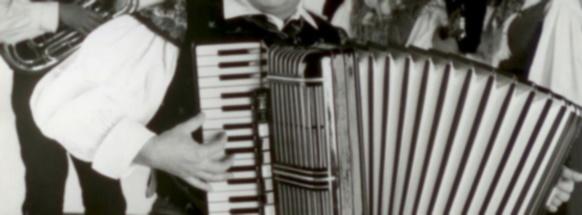
Slovenian/Oberkrainer style accordion rhythm is a technique used by Slovenian and Austrian alpine style accordionists to complete the rhythm section in a trio or quintet, by playing chords repeatedly as semiquavers in polkas, or quavers in waltzes. In Slovenian it’s known as ‘tresenje‘ (shaking), for its ‘shaking’ sound, and ‘spremljavo‘ (accompaniment). In German it’s called ‘Oberkrainer begleitung‘ (Oberkrainer accompaniment). In trios with vocals, or quintets with a trumpet and clarinet, the accordion never only sticks to melody or rhythm, but fluidly alternates between melody and rhythm.
It was developed by Slavko Avsenik who wanted to create a fuller sounding rhythm from the accordion while accompanying the melody sections (vocals and trumpet with clarinet) in his iconic ‘Oberkrainer’ style, which evolved from the 1950s onward. Here is an explanation which is on display at the Avsenik Museum in Begunje na Gorenjskem, Slovenia:
He felt that he needed to repeat the first note in a bar – so the crotchet in a waltz was played as two quavers, the quaver in a polka was played as two semiquavers, and for the chord he always used the quintal chord. Only with this kind of rhythmical playing of the accompaniment, which actually replaces percussion (drum sticks), he gave the music, especially the polka, real life energy.
The translations on display at the Avsenik Museum call it ‘tresenje‘ in Slovenian, ‘flattern‘ in German and ‘tremolo‘ in English. However tremolo is better known for the vibration that comes from an accordion’s musette tuning.
The effect is an energetic rhythm, which, when completed with bass/baritone and guitar, doesn’t need any additional percussion whatsoever. Coincidentally, a similar effect is now used in some forms of modern music.
I’d also like to add that there is not much you need to do with the bellows, in this technique. As opposed to the American-Polish polka style, there is definitely no actual bellow shaking (in and out shaking of the bellows). Depending on how you naturally move the bellows during playing, this will accentuate the effect anyway. There is no perfect way to do Oberkrainer accompaniment, and you will find that all accordionists vary slightly in their technique (some accordionists don’t even play the bass notes since the basses aren’t very important here, and some tap their left hand slightly on the bass side just to accentuate the effect).
This technique has since been used by thousands of accordionists around the world who play this style, predominantly in Europe, but also spanning to North and South America, Japan, and Australia. Every Slovenian/Oberkrainer style accordionist uses this technique, whether accompanying a band or just another accordionist.
I’ve been asked several times how this sound is achieved, and luckily now there are online resources that can help you learn, for free. Since it is hard to find any resources in English, hopefully this list can help anyone who cannot speak German or Slovenian.
TurboReini’s ebooks
Reini (TurboReini) from Germany with Mario Brunetti published 3 free ebooks to help learn the technique for piano accordion, and 2 ebooks for the diatonic button accordion (steirische harmonika). They can be obtained from turboreini.de (add it to your cart, then download it for free). I’ve linked to them below to help anyone who doesn’t understand German (although you can use Google Translate on his website). The books are mostly sheet music with different variations and techniques that can be used, along with fingering and different keys/chords. You don’t have to understand German to understand these ebooks:
- Piano accordion book 1 (polka)
- Piano accordion book 2 (polka)
- Piano accordion book 3 (waltz)
- Button accordion book 1 (polka)
- Button accordion book 2 (waltz)
However, reading sheet music isn’t a requirement to learn anything in music, after all Avsenik himself did not learn how to read sheet music until later in his life. Reini has also made videos explaining the technique. Although it’s in German, he shows the technique slowly and clearly as he’s doing it.
Other resources on YouTube
I hope you’ve found this helpful. Please contact me or leave a comment, if you’d like any additional pointers on the technique.